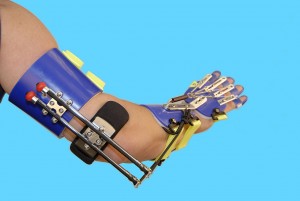After neurological injury the arm and hand is often weak making it difficult to open the hand and grip objects with enough force to confidently perform a task such as picking up a mug. Current research suggests that it is important to do intensive, functionally based exercises to create new pathways in the brain, therefore improving the probability of using the arm and hand again in day to day tasks.
Achieving the necessary amount of practise is very challenging for many people as they need assistance from a therapist to open their hand for them to grasp an object.
If you would like to discuss how we may be able to help you further or to arrange an appointment, please contact us.
01223 655653
info@htrehab.co.uk
Alternatively fill in our enquiry form.
Enquiry formAt Hooley and Tuke we offer a range of options to suit people with different rehabilitation needs. This includes programs and products designed to increase the intensity of practice to improve the use in your arm and advice and products designed to manage pain and stiffness in a very weak arm.
For very weak hands and arms:
- Mirror Box Therapy
- Electrical Stimulation
- Advice on splints and stretching programs to maintain range of movement and manage pain
For hands with some strength to flex the fingers:
- SaeboFlex and Saebo Reach
- Electrical Stimulation
For hands with some strength to partially open and flex the fingers:
- Constraint Therapy
- SaeboFlex, Saebo Reach and Saebo Glove
- Functionally based home exercise programs i.e. picking up bottles, coins, plates etc.
Mirror Box Therapy:
For those with little or no activity in the arm, Mirror Box Therapy has been found to be effective in promoting recovery. Your arm and hands are positioned on a table in front of you with your weak arm and hand inside a box with a mirror which faces your strong side. By performing movements with your strong side whilst looking in the mirror, your brain is tricked into thinking it is your weak side making the movements. This has been shown to increase excitability of the nerves in the damaged side of the brain in people who have had a Stroke though other neurological conditions such as head injury and spinal cord injury are likely to benefit.
Saebo Products
Saebo is a leading provider of innovative rehabilitation products for people with a neurological condition. Their products include the SaeboFlex and SaeboReach which are designed for people with very little residual arm and hand function to immediately begin grasping and releasing, so you can receive a daily dose of therapy without the need for a therapist.
SaeboFlex and SaeboReach are suitable for people with:
- Stroke
- Head Injury
- Spinal Cord Injury
- Multiple Sclerosis
The SaeboFlex works through springs which open your fingers and thumb to achieve an optimal position for gripping objects. The spring also acts as a resistance to closing your hand and therefore can improve your grip strength. We can alter the resistance of the spring to increase your grip strength and the strength of muscles which open your hand as you improve.
Some people with weakness in their arm have difficulty relaxing at the elbow with the forearm flexed up around the abdomen. The SaeboReach adds an upper arm cuff to the Saeboflex, helping you to straighten your elbow when performing reaching practice.
At Hooley and Tuke we are a free assessment site for Saebo and offer a 20% discount on the SaeboFlex and SaeboReach products.
Electrical Stimulation
Electrode pads are placed on the skin of the forearm. A small electrical current is passed through the electrode pads from a stimulator unit to enable your muscles to straighten and flex your fingers and lift or bend your wrist. Electrode pads can also be placed higher up the arm to bend and straighten the elbow and even lift the whole arm.
Electrical Stimulation has been shown in a number of research studies to increase excitability of nerves in the damaged part of the brain and improve the ability to perform activities with the hand and arm when compared to those not using electrical stimulation (but performing the same exercises). Electrical Stimulation has also been shown to reduce spasticity after use.
Constraint Induced Movement Therapy (CIMT)
CIMT is essentially forcing you to use your weak hand and arm. There are different methods of achieving this but essentially your strong side is “constrained” through wearing a specially designed mitten or glove so you are unable to pick objects up with your strong hand.
There is excellent evidence that CIMT works though it is hard work. The majority of the evidence supports its use for people who have had a stroke. People participating in CIMT are expected to wear the constraint for 90% of the time you are awake and are also expected to participate in many hours of exercises every day for 2 weeks. It is hard work but the improvement in the ability to use the hand and arm in every day activities can be excellent.


